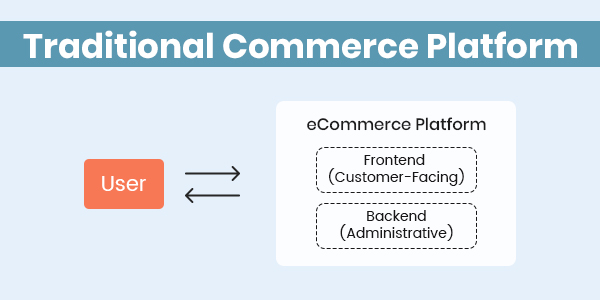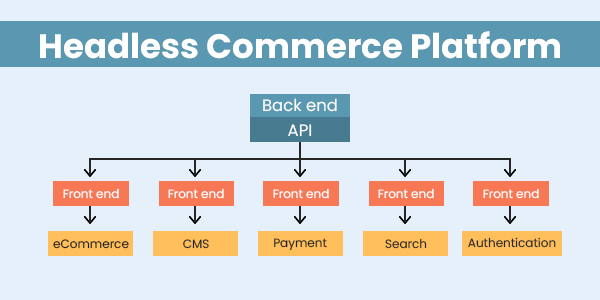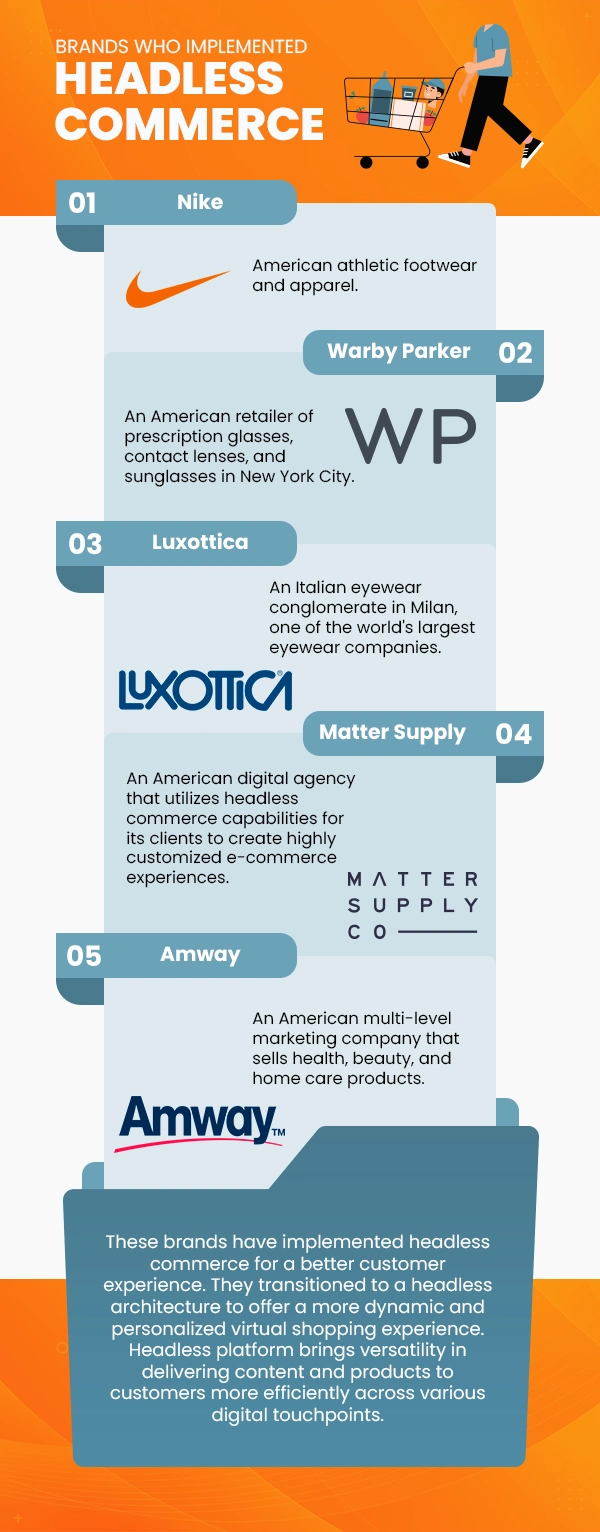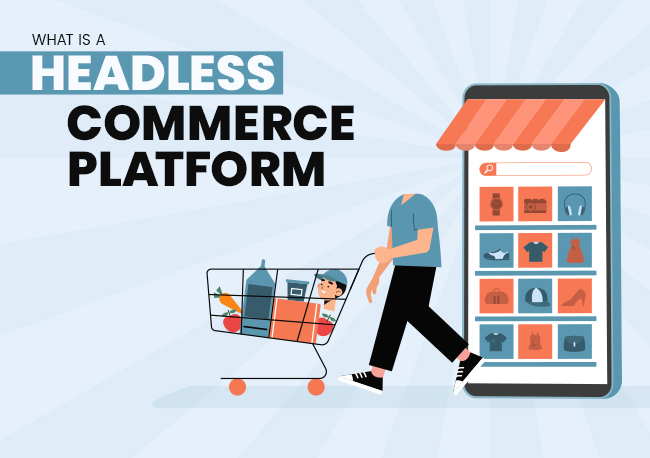| Getting your Trinity Audio player ready... |
Today, in the ever-changing landscape of e-commerce, companies often seek innovative ways to enhance their virtual presence, improve customer experiences, and maintain a competitive edge. One of the most captivating advancements in this space is the adoption of headless commerce platforms.
In the era of the digital revolution, consumers demand more from their virtual window shopping experiences than ever before. They expect seamless, personalized, and blazingly quick interactions with their favorite brands, and this is where headless commerce platforms play their game for brands to increase the user experience.
In this comprehensive guide, we will look at the realm of headless commerce, starting from its definition, benefits, and differences from traditional commerce to the top platforms of 2023.
Understanding Traditional Commerce Platform
Before flying towards the complexities of headless commerce, it’s necessary to get a grip on the foundation upon which it was built – the traditional commerce platform.
Also Read: Complete Guide To The Content Management System
What is a Traditional Commerce Platform?
Traditional commerce platforms, typically monolithic or coupled e-commerce solutions, are integrated systems with tightly interconnected front-end (customer-facing) and back-end (administrative) aspects. These platforms include pre-configured templates and frequently lack adaptability.

Limitations of Traditional Commerce Platforms
Traditional commerce platforms are limited in many terms while competing in the booming business market. They struggle to adapt to rapid technological upgrades and consumer preferences, resulting in hurdles such as slower time-to-market, limited scalability, and a restricted ability to deliver highly customized user experiences.
Limitations
- Struggle to Adapt Technological Upgrades and Customer Preferences
- Slower Time-To-Market
- Limited Scalability
- A Restricted Ability to Deliver Highly Customised User Experiences
Also Read: 17 Top Technical Requirements For Your eCommerce Websites
What is a Headless Commerce Platform?
Now, let’s dive deep into the concept of a headless commerce platform.
A headless commerce platform decouples the front end from the back end, enabling businesses to generate a flexible, customizable, and highly personalized shopping experience. To be specific and straightforward, it isolates the “head” (the front end) from the “body” (the back end), offering the autonomy to utilize various technologies for each.

This approach empowers businesses to craft unique user interfaces while seamlessly integrating with diverse third-party applications and services.
Below are some real-world facts, statistics, and examples to provide a deeper understanding of what a Headless Commerce Platform is:
Real-World Statistics:
| 1 | 62% of companies agree that headless eCommerce can significantly increase engagement and conversions. – BusinessDIT |
| 2 | 69% of the consumers expressed positive happiness with the personalized shopping experiences they receive through headless commerce platforms on websites. – Gitnux |
| 3 | Over six in ten retail companies plan to migrate to headless commerce platforms by 2024, while over 20 percent of them already use them. – Statista |
| 4 | 80% of businesses that don’t have headless architecture today say they plan to implement it in the next two years – Vue Storefront |
| 5 | Digital leaders intend to spend 25% more on digital experiences, including Headless CMS, in the coming year. – experro |
*Note: The statistics presented above are sourced from third-party research entities, i.e. Vue Storefront, Gitnux, experro, Statista, and BusinessDIT; however, we neither endorse them nor advise making decisions solely based on these figures without expert consultation.

This real-world data optimistically highlights how businesses from various industries adopted headless commerce platforms, enhanced their online presence, offered personalized shopping experiences to their consumers, and stayed competitive in the rapidly evolving digital landscape.
Headless commerce is never limited to specific niches; it is a flexible approach that can benefit businesses of all types and sizes.
Also Read: A Useful Guide To Building An eCommerce Website From Scratch
Headless vs. Traditional Commerce: What’s the Difference?
To understand headless commerce better, let’s compare it to traditional commerce.
| Traditional Commerce | Headless Commerce |
| ➢ Tightly coupled front-end and back-end. ➢ Limited flexibility and scalability. ➢ Predesigned templates for the user interface. ➢ Slower time-to-market. ➢ Challenging to adapt to changing technology. | ➢ Decoupled front-end and back-end. ➢ High flexibility and scalability. ➢ Customizable user interfaces. ➢ Faster time-to-market. ➢ Seamless integration with third-party services. |
6 Benefits of Headless Commerce Platform
1. Flexible and Scalable
The decoupled front-end and back-end, which gives freedom to the organization to choose the technologies and tools that best suit their needs, makes it the most flexible and scalable. Such agility makes it quickly adaptable in today’s competitive market, where consumer demand lies with technological advancements.
2. Offers Enhanced User Experience
Enhanced user experience is the key that makes headless commerce platforms the most excelling. The separation of both front and back-end concerns brings advancements into user experience by allowing the integration of highly customized and engaging customer interfaces. This personalization can significantly boost customer satisfaction and loyalty.
Also Read: What Makes A Good Website Checklist? A Complete Guide
3. Have Omnichannel Capabilities
In today’s multi-channel retail landscape, having a presence across various online and offline platforms is vital. Headless commerce platforms are designed to support omnichannel strategies, ensuring a consistent brand experience across all touchpoints.
4. Better Speed & Performance
With the traditional commerce model, the front-end and back-end are tightly coupled, which can lead to slower website loading times and performance issues. On the other hand, headless commerce platforms are known for their speed and performance, ensuring that your website or application responds swiftly to customer interactions.
Also Read: Website Optimization Tips To Increase Website Performance
5. Reduced Time-to-Market
Time is of the essence in e-commerce. Headless commerce solutions offer faster time-to-market, allowing you to roll out new features and updates more rapidly. This adaptability can provide you with a competitive advantage in the market.
6. Cost Efficiency
‘Headless Commerce is cost-prohibitive; this is the biggest myth if we look at the solution efficiency against actual technology and infrastructure requirements.
By selecting the right match after analyzing the technological requisites and optimizing your infrastructure, you can create a cost-effective adoption plan under which the Headless Commerce Platform fits without any extra investment demands.
Also Read: Types Of eCommerce Websites And Models
5 Best Headless eCommerce Platforms in 2023 Shopify
In 2023, the landscape of headless eCommerce platforms has evolved significantly, offering businesses an array of options to build flexible, scalable, and customer-centric online stores.
Here are the top 5 headless eCommerce platforms that stand out in the current year:
1. Shopify
Shopify, a leading name in eCommerce, has also embraced the headless approach. With its recent expansion into the headless space, Shopify now provides a decoupled architecture, allowing businesses to separate the front and back end.
This provides flexibility and speed in delivering tailored customer experiences while harnessing Shopify’s robust back-end features.
Pros:
- Beginner-friendly: Shopify’s user-friendly interface and easy setup process make it accessible for users with little to no technical experience.
- Robust app store: Shopify has a big app store, allowing users to extend the functionality of their virtual store with various plugins and integrations.
- Reliable hosting: With Shopify, users don’t have to worry about managing hosting and server maintenance, as Shopify takes care of it.
- Mobile optimization: Shopify offers responsive themes and gives importance to mobile-friendly website checkout, ensuring a seamless shopping experience for mobile users.
- Excellent customer support: Shopify provides 24/7 customer support through various channels, including live chat, email, and phone, ensuring help is readily available.
Cons:
- Limited design flexibility: While Shopify offers a wide range of themes, customization options are somewhat restricted compared to other platforms.
- Transaction fees: If users pay through third-party gateways and don’t use Shopify’s payment gateway, they may have to face additional transaction fees.
- Monthly costs: Although Shopify offers various costing plans, users still have to pay a monthly fee, and this might not be ideal for small or unicorn businesses with limited budgets.
- Limited multi-store capabilities: Shopify’s multi-store features are not as competitively advanced as others, making it less suitable for businesses with multiple brands or stores.
- Limited scalability: As a hosted platform, Shopify’s scalability may be limited compared to self-hosted options.
Also Read: What Types Of Information ECommerce Sites Need To Protect?
2. Adobe Commerce (Magento)
Regarding the eCommerce industry, Adobe Commerce, formerly known as Magento, always leads the competition board because of its comprehensive suite of tools. The advanced tool kit of Adobe Commerce includes many headless capabilities catering to the needs of both small businesses and enterprise-level organizations.
It provides the flexibility to build custom front ends while leveraging its powerful back end for inventory management, order processing, and more.
Pros:
- Customization options: Adobe Commerce offers extensive customization options, making it suitable for businesses with unique needs and complex product catalogs.
- Powerful feature set: Magento is known for its rich set of features, allowing users to create advanced and robust eCommerce stores.
- Scalability: Magento can handle high volumes of traffic and products, making it a good option for businesses with rapid growth plans.
- Extensive third-party integrations: Magento has a vast marketplace for extensions, providing users with countless integration options to extend their store’s functionality.
- Strong developer community: Magento has a large and active developer community, ensuring a wealth of resources and support for users.
Cons:
- Complexity: For users without technical skills, Magento can be a complex choice to set up and manage. It may not work for the beginners.
- Cost: Adobe Commerce (formerly Magento Commerce) is comparatively more expensive than other eCommerce platforms, especially when we look at the development, hosting, and maintenance costs.
- Hosting Requirements: Magento has specific server and hosting requirements, which may involve additional costs and technical expertise.
- Learning curve: Due to its complexity, Magento has a steep learning curve, requiring more time and effort to become proficient.
- Slow performance: If not properly optimized and hosted, Magento can be resource-intensive and might suffer from slower page load speeds.
Also Read: How To Fix A Slow Website?
3. BigCommerce
BigCommerce has established itself as a versatile and developer-friendly headless eCommerce platform. It offers a range of APIs and tools to facilitate headless commerce implementations.
The platform’s flexibility particularly appeals to businesses seeking to create unique shopping experiences and integrate with various third-party services.
Pros:
- Ease of use: BigCommerce offers a user-friendly interface, making it accessible to users with little technical expertise.
- Multi-channel selling: BigCommerce allows users to sell through various channels, including marketplaces like Amazon and eBay, making it suitable for omnichannel strategies.
- Responsive themes: BigCommerce offers a wide range of mobile-responsive themes, ensuring a seamless shopping experience across devices.
- Strong SEO capabilities: BigCommerce provides tools and features to optimize eCommerce websites for search engines, helping businesses rank higher in search results.
- High reliability and security: BigCommerce handles hosting, security updates, and server maintenance, providing users with a reliable and secure eCommerce website.
Cons:
- Limited customization options: While BigCommerce offers some flexibility, the level of customization might not be as extensive as other platforms.
- Transaction fees: Depending on the chosen plan, BigCommerce may charge additional transaction fees on top of credit card fees.
- Pricing: BigCommerce’s fees might be higher compared to other platforms, especially for high-volume businesses.
- Limited scalability: BigCommerce may face scalability limitations when dealing with larger product catalogs and high traffic volumes.
- Limited international features: BigCommerce’s international features, such as multi-currency support, might be limited compared to other platforms.
Also Read: Best Content Management System Platform Optimized For SEO
4. Commercetools
Commercetools is a cloud-native, API-first commerce platform known for its headless capabilities. Its microservices architecture allows businesses to construct their eCommerce stack with agility, making it an excellent choice for enterprises looking to innovate and adapt quickly.
Commercetools also supports multi-tenancy and international expansion.
Pros:
- Headless architecture: Commercetools is a headless platform offering flexibility, scalability, and the ability to create custom front-end experiences.
- API-driven: Commercetools is built on a modern API architecture, allowing seamless integrations with various systems and channels.
- Scalability: Commercetools can handle high volumes of traffic and large product catalogs, making it suitable for businesses with rapid growth plans.
- Flexibility and customizability: With Commercetools, businesses have the flexibility to build tailored eCommerce solutions that match their unique needs.
- Developer-friendly: Commercetools provides developers with a set of powerful tools and resources, enabling them to create innovative eCommerce experiences.
Cons:
- Complexity: Commercetools can be complex to set up and manage, requiring technical expertise. It might not be the best choice for beginners or businesses without development resources.
- Cost: Commercetools tend to be more expensive than traditional eCommerce platforms, especially when considering development and customization costs.
- Dependency on developers: The flexibility offered by Commercetools often requires ongoing developer support and expertise, increasing dependency on technical resources.
- Learning curve: Due to its advanced features and headless architecture, Commercetools has a steep learning curve, requiring dedicated time and effort to master.
- Potential integration challenges: While Commercetools provides extensive integration capabilities, integrating it with legacy systems or existing infrastructure may pose challenges.
Also Read: WordPress: Is It A Viable Option For eCommerce?
5. Salesforce Commerce Cloud
Salesforce Commerce Cloud provides a headless commerce solution within its comprehensive ecosystem. Leveraging the power of Salesforce’s CRM and marketing capabilities, businesses can create personalized and connected shopping experiences.
The platform supports various front-end frameworks, enabling developers to design unique customer touchpoints.
Pros:
- Powerful CRM integration: Salesforce Commerce Cloud seamlessly integrates with Salesforce CRM, allowing businesses to leverage customer data and personalize the shopping experience.
- Scalability: Salesforce Commerce Cloud can handle high volumes of traffic and large product catalogs, making it suitable for businesses with rapid growth plans.
- Multichannel selling: Salesforce Commerce Cloud supports selling through multiple channels, including web, social media, and physical stores, enabling omnichannel strategies.
- Strong B2B capabilities: Salesforce Commerce Cloud offers robust features and functionalities for B2B eCommerce, making it suitable for businesses in this sector.
- Strong partner ecosystem: Salesforce Commerce Cloud has a vast network of partners, ensuring access to additional resources, integrations, and expertise.
Cons:
- Cost: Salesforce Commerce Cloud tends to be more expensive compared to other eCommerce platforms, particularly for small businesses or startups.
- Complexity: Salesforce Commerce Cloud can have a steep learning curve, and configuration requires technical expertise.
- Customization limitations: The level of customization Salesforce Commerce offers may fail to offer the same level of flexibility as other platforms.
- Potential dependency on the Salesforce ecosystem: Using Salesforce Commerce Cloud could lead to higher reliance on the Salesforce ecosystem, which might limit flexibility in selecting other vendors.
- Support availability: Salesforce Commerce Cloud support might not be as easily accessible or responsive compared to other platforms’ support channels.
These five headless eCommerce platforms in 2023 offer a range of features, scalability, and flexibility to suit businesses of all sizes and industries. Choosing the best fit depends on specific business needs, as all platforms have specialties in various technical areas.
With the evolution of eCommerce, these platforms will play a vital role in helping organizations stay competitive and meet the growing demands of online purchasers.
Also Read: Website Development Checklist To Help Create Your First Website
Conclusion
Headless commerce platforms have emerged as a game-changer in a digital era where adaptability, speed, and personalized experiences are priorities for individuals. Decoupling the front and back end offers organizations the freedom to innovate, scale, and deliver exceptional customer experiences.
To succeed in your e-commerce strategies, you should be prepared for all the possible technology adoption capabilities without sticking to headless commerce, as it is not a one-size-fits-all solution. Defining the objectives before approaching the headless method is important to verify whether it fits you.
Incorporating a headless commerce platform may be the key to unlocking new opportunities, staying competitive, and delivering the seamless shopping experiences that modern consumers expect.
FAQs
Yes, headless commerce can benefit businesses of all sizes. Small businesses can leverage headless solutions to create tailored user experiences and compete effectively in the digital market.
Headless commerce can positively impact SEO by providing faster loading times and more customizable content structures. However, it’s crucial to implement SEO best practices to maximize its benefits.
Yes, headless commerce platforms are designed to facilitate integrations with existing systems. This allows businesses to leverage their technology stack while adopting a more flexible front-end.
Security is essential in headless commerce. To enhance security, businesses should implement robust authentication, authorization, and encryption measures. Regular security audits and updates are also crucial.




